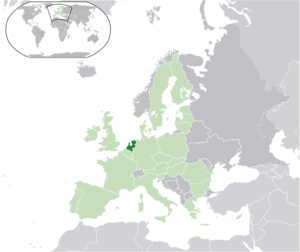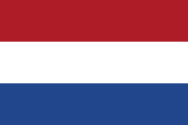Netherlands
| Netherlands |
|
|
The Netherlands is a country in Western Europe. Its population is 16.6 million. Its official language is Dutch and its capital and largest city is Amsterdam. The adjective that belongs to the Netherlands is Dutch.
In Europe, the Netherlands consists of twelve provinces, bordering Germany to the east, Belgium to the south, and the North Sea to the northwest, with maritime borders in the North Sea with those countries and the United Kingdom. In the Caribbean, it consists of three special municipalities in the Caribbean: the islands of Bonaire, Sint Eustatius, and Saba. The country's official language is Dutch, with West Frisian as a secondary official language in the province of Friesland, and English and Papiamento as secondary official languages in the Caribbean Netherlands. Dutch Low Saxon and Limburgish are recognized regional languages (spoken in the east and southeast respectively), while Dutch Sign Language, Sinte Romani, and Yiddish are recognized non-territorial languages.
The Netherlands is a geographically low-lying and densely populated country. It is popularly known for its windmills, cheese, clogs (wooden shoes), delftware and gouda pottery, dikes, tulips, bicycles, and social tolerance. A liberal democracy, the country is also well-known for its liberal policies toward drugs, prostitution, gay rights, abortion, and euthanasia.
Modern History
The Netherlands was able to remain neutral during World War I, in part because the import of goods through the Netherlands proved essential to German survival until the blockade by the British Royal Navy in 1916. That changed in World War II when Nazi Germany invaded the Netherlands on 10 May 1940. The Rotterdam Blitz forced the main element of the Dutch army to surrender four days later. During the occupation, over 100,000 Dutch Jews were rounded up and transported to Nazi extermination camps; only a few of them survived. Dutch workers were conscripted for forced labor in Germany, civilians who resisted were killed in reprisal for attacks on German soldiers, and the countryside was plundered for food. Although there were thousands of Dutch who risked their lives by hiding Jews from the Germans, over 20,000 Dutch fascists joined the Waffen SS, fighting on the Eastern Front. Political collaborators were members of the fascist NSB, the only legal political party in the occupied Netherlands. On 8 December 1941, the Dutch government-in-exile in London declared war on Japan, but could not prevent the Japanese occupation of the Dutch East Indies (Indonesia). In 1944–45, the First Canadian Army, which included Canadian, British, and Polish troops, was responsible for liberating much of the Netherlands.
Soon after VE Day, the Dutch fought a colonial war against the new Republic of Indonesia.
In 1954, the Charter for the Kingdom of the Netherlands reformed the political structure of the Netherlands, which was a result of international pressure to carry out decolonization. The Dutch colonies of Surinam and Curaçao and Dependencies and the European country all became countries within the Kingdom, on a basis of equality. Indonesia had declared its independence in August 1945 (recognized in 1949), and thus was never part of the reformed Kingdom. Suriname followed in 1975. After the war, the Netherlands left behind an era of neutrality and gained closer ties with neighboring states. The Netherlands was one of the founding members of the Benelux, the NATO, Euratom, and the European Coal and Steel Community, which would evolve into the EEC (Common Market) and later the European Union.
Government-encouraged emigration efforts to reduce population density prompted some 500,000 Dutch people to leave the country after the war. The 1960s and 1970s were a time of great social and cultural change, such as rapid de-pillarisation characterized by the decay of the old divisions along political and religious lines. Youths, and students, in particular, rejected traditional mores and pushed for change in matters such as women's rights, sexuality, disarmament, and environmental issues. In 2002 the euro was introduced as fiat money, and in 2010 the Netherlands Antilles was dissolved. Referendums were held on each island to determine their future status. As a result, the islands of Bonaire, Sint Eustatius, and Saba (the BES islands) were to obtain closer ties with the Netherlands. This led to the incorporation of these three islands into the country of the Netherlands as special municipalities upon the dissolution of the Netherlands Antilles. The special municipalities are collectively known as the Caribbean Netherlands.
Spanking in the Netherlands
Spanking has a long tradition in the Netherlands, just like its neighboring countries France, Belgium, and Germany. Because of the Dutch colonies in Southeast Asia, rattan canes were easy to import at low cost in the 19th century.
Spanking is called billenkoek or billekoek in Dutch.
Dutch spanking art
The spanking artist Funbun lives both in the Netherlands and New Zealand.
Wulfram is a Dutch spanking author and webmaster.
Amsterdam has two "Sex Museums" that exhibit BDSM and spanking implements and also some spanking art.
See also
| This page may use content from Wikipedia. The original article was at Netherlands. The list of authors can be seen in the page history. |
Chat rooms • What links here • Copyright info • Contact information • Category:Root

